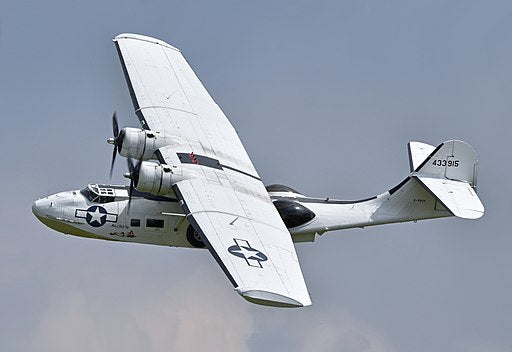When we look back through aviation history, a few aircraft truly stand out. One in particular is the Consolidated PBY Catalina. This remarkable flying boat was celebrated for its versatility and storied legacy. It took center stage during World War II and continued to demonstrate its value in the post-war era. Several unique traits set the PBY-5 apart from its enhanced counterpart, the PBY-5A. These aircraft hold a special place in the captivating story of aviation, serving as witnesses to the ongoing evolution of the intricate relationship between technology and design, molded by the ever-shifting demands of both wartime and post-war missions.
The Birth of the PBY-5
The genesis of the PBY Catalina can be traced back to the 1930s, a period characterized by rapid innovation in aviation. Born out of the pressing need for a long-range reconnaissance and patrol aircraft, the PBY-5, heralded as the PBY-5 Catalina, emerged as the inaugural major production variant in 1939. Its distinctive high wing configuration, housing two radial engines atop the wings, the twin-tail design, and a water-landing compatible hull rendered it a versatile marvel of engineering. With amphibious capabilities intrinsic to its design, the PBY-5 proved adept at patrolling vast expanses of oceanic territory.
The Engines
The main difference between the PBY-5 and its successor, the PBY-5A, was rooted in the engine choice. The PBY-5 was equipped with Pratt & Whitney R-1830 Twin Wasp engines, summoning forth a combined power of approximately 1,200 horsepower. Though reliable, these engines lacked the superchargers requisite for optimal performance at higher altitudes.
The Evolution to PBY-5A
The emergence of the PBY-5A, with the “A” signifying “amphibian,” retained the aircraft’s inherent amphibious capabilities from its original design. Yet, the most profound transformation manifested in more potent engines. The PBY-5A boasted Pratt & Whitney R-1830-92 Twin Wasp engines with two-stage superchargers. This augmentation catalyzed a substantial improvement in the aircraft’s performance at elevated altitudes, an attribute of paramount significance in its role in anti-submarine warfare.
Performance and Range
The advent of the R-1830-92 engines gave the PBY-5A a substantial advantage concerning performance and range. These new engines proffered a formidable power boost, culminating in an impressive top speed of approximately 196 mph (315 km/h) and a service ceiling that reached a lofty 16,000 feet. This augmented altitude capability proved indispensable in the ongoing struggle against enemy submarines, affording enhanced visibility and evasive maneuvers in the face of adversary fire.
Regarding range, the PBY-5A could traverse an extensive 2,545 miles (4,100 kilometers) on its internal fuel reservoirs, a commendable improvement over the PBY-5’s roughly 2,345 miles (3,775 kilometers) range. This amplified range conferred invaluable prowess during prolonged missions, encompassing extended patrols and high-stakes search-and-rescue operations.
Operational Roles
The PBY-5 and the PBY-5A carved out indispensable roles during World War II. The PBY-5, equipped with its reliable albeit less potent engines, predominantly served as a reconnaissance and patrol aircraft, scouring the vast expanses of the Pacific and Atlantic Oceans to pursue enemy ships and submarines. Moreover, it undertook the noble responsibility of executing search-and-rescue missions, which saved innumerable lives.
In stark contrast, the PBY-5A, furnished with its upgraded engines, was tailor-made for anti-submarine warfare. Its heightened performance capabilities elevated its efficacy in engaging enemy submarines, and it assumed a pivotal role in the Battle of the Atlantic, a theater wherein German U-boats posed an imminent and formidable threat to Allied shipping.
Conclusion
The evolutionary trajectory of the Catalina, from the PBY-5 to the PBY-5A, serves as a poignant testament to the adaptability and ingenuity of aircraft designers during a pivotal juncture in history. Integrating more potent engines into the PBY-5A brought about a palpable enhancement in its performance and operational capacities, solidifying its standing as an indomitable force in maritime aviation. The legacies of both iterations of the Catalina resonate resoundingly through the annals of aviation history, cherished by enthusiasts and historians alike on a global scale.
For more insights into the PBY-5A and other important military aircraft, visit Aces In Action. Here, you’ll find an amazing piece of artwork by Craig Tinder titled “Moonlit Nemesis,” which illustrates and pays tribute to the pilots and crews who flew the perilous bombing and sea rescue missions with the PBY Catalina. The limited edition canvas print even includes a piece of an actual fragment of control surface fabric from a restored PBY-5A Catalina, making it a unique piece of history!
Moonlit Nemesis – PBY-5A Catalina Aviation Art by Artist Craig Tinder
28 August 1942 – VP-92’s PBY Catalina BuNo. 7295 embarked on a daring night mission from Guantanamo Bay, escorting a convoy heading for the Windward Passage between Cuba and Haiti. Close to midnight, the PBY spotted the German U-boat, U-94, under hazy moonlight. The submarine, about to fire a torpedo, initiated a crash-dive upon detecting the aircraft. The Catalina released four depth charges, disabling U-94’s diving panes. The Canadian corvette HMCS Oakville then rammed and sunk the U-boat, resulting in 19 casualties. U-94 had previously completed nine war patrols and sunk 26 ships.






Share:
First Ukranian Front, the story behind "Konev's Approach to Berlin"
Battle of Leyte Gulf, the story behind "USS Langley CVL-27"